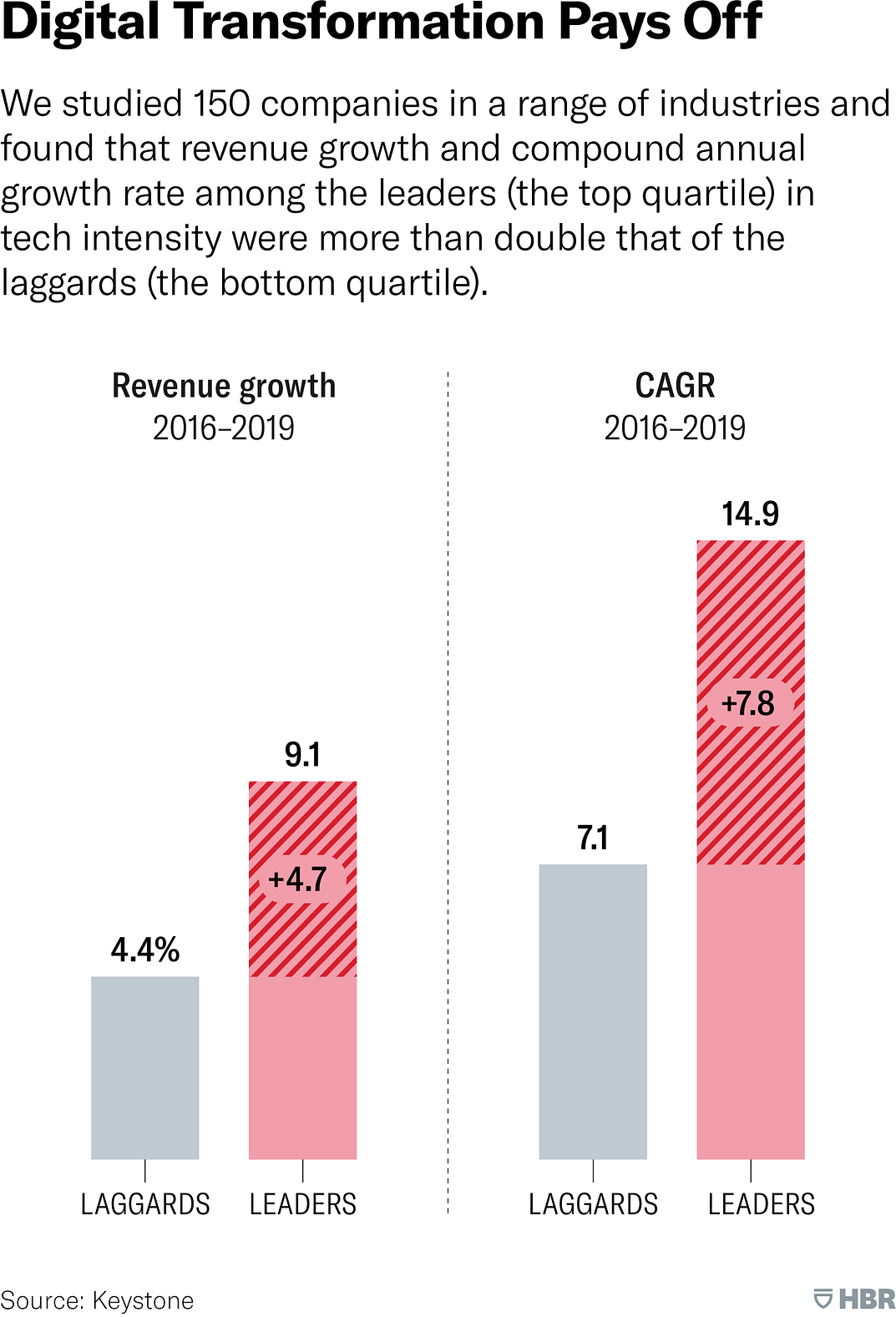This is an excerpt of the article below, with the title above, focusing on the topic in theme.
Democratizing Transformation — The case of Novartis and Microsoft
And the results of a 150 organizations survey
Harvard Business Review
by Marco Iansiti and Satya Nadella
From the Magazine (May–June 2022)
Summary (of the full version of the article)
Many companies struggle to reap the benefits of investments in digital transformation, while others see enormous gains. What do successful firms do differently?
This article describes the five stages of digital transformation, from the traditional stage, where digital and technology are the province of the IT department, through to the platform stage, where a comprehensive software foundation enables the rapid deployment of AI applications.
The ideal is the native stage, whose hallmarks are an operating architecture designed to deploy AI at scale across a huge, distributed spectrum of applications; a core of experts; broadly accessible, easy-to-use tools; and investment in training and capability-building across the enterprise.

Staging the Transformation
Our analysis confirms that just spending money on technology does not result in more growth or better performance; in fact, in some cases it can actually damage the business if it accentuates divisions and inconsistencies across groups.
Instead, it is the architectural, managerial, and organizational approaches to transformation that best explain the substantial and enduring differences among firms.
We found that companies typically progress through five stages on their transformation journey.
- Traditional model.
- Bridge model
- Hubs Model
- Platform model
- Native model
1.Traditional model.
Not surprisingly, many companies fit what we consider to be the traditional model of digital innovation, whereby digital and technology investments are the province of the IT department (or other technical specialist groups) and impact is scattered across groups, mostly in inconsistent ways.
IT works with business units to fund projects and manage implementation-say, for the deployment of an enterprise application or a data platform technology.
The projects and their implementations are customized to the specific requirements of the individual silos, business units, or functions.
The result is that over time, the technology and data infrastructure reflect the quirks of individual groups, without any consistency and connectivity.
This sort of disjointed approach makes it virtually impossible to share, scale, or distribute innovation efforts across the organization.
Many businesses in the traditional model still spend a great deal of money on information technology.
Consider a financial services firm we studied, whose tech and analytics budget is among the top in its industry, in both absolute and relative terms. The company has spent heavily on state-of-the-art data-platform technology and hired thousands of IT specialists and data scientists, who sit isolated in a separate IT group, while few (if any) employees on the business side are involved in the organization’s digital innovation efforts. The company thus lacks the architecture and capabilities required to foster any intensity in tech adoption. Not surprisingly, the firm’s IT and data sciences efforts have stalled, and business impact has been minimal.
A telltale sign that a company is in the traditional stage is that perceptions of impact among technology and business employees are dramatically different.
The former perceive impact to be high (as measured by the effort they put into their work), while the latter measure it as much lower (according to how their everyday activities have benefited).
2.Bridge model
To break free of the traditional constraints of silos-organizational and infrastructural-companies typically start by launching pilots that bridge previously separate groups and developing shareable data and technology assets to enable new innovations.
They might first focus on specific functional opportunities such as optimizing advertising, manufacturing, or supply-chain capabilities.
These companies are piloting not only technology but also a fundamentally different model of innovation in which executives, managers, and frontline workers from the business side work in collaboration with IT and data scientists.
Victor Bulto, Novartis’s head of U.S. pharmaceuticals, was instrumental in launching early pilots (focusing, for example, on identifying at-risk patients) and served as a champion for many initiatives as the organization moved through the bridge stage.
Lori Beer, JPMorgan Chase’s global CIO, likes to talk about the demonstrated impact of piloting AI to simplify expense reporting and approval-a process-improvement pilot that won over many employees.
3.Hubs
As more and more pilots demonstrate the success of the new approach, organizations form data and capability hubs and gradually develop the capacity to link and engage additional functions and business units in pursuit of opportunities for transformation.
As they progress down this path, leaders begin to realize that the bottleneck in innovation has shifted from investments in technology to investments in the workforce.
The limiting factor at this stage is the number of business employees with the capability-the know-how and the access-to drive digital innovation.
Companies thus need to invest in coaching and training a much larger community of employees.
Fidelity strives to develop what it calls digital athletes.
It began to build hubs by creating centralized data assets (a companywide data lake, for example); now it is scaling up training for thousands of business employees, giving them the capacity to deploy digitally enabled solutions across the entire business.
Digitally savvy investment specialists and tax experts, for example, are working closely with data scientists and technologists to create innovative solutions with a special focus on personalization and tailored customer impact.
They’ve also created an app aimed at onboarding and engaging younger investors and another app for delivering AI-powered recommendations to Fidelity financial advisers, to name just a few examples.
Starbucks, too, is focused not only on technology and architecture but also on developing broad-based, agile innovation skills in its employees to power its hubs.
CEO Kevin Johnson explains, “We’ve gone from large teams working in silos to smaller, cross-functional teams [everywhere], and from evaluating every idea as pass-fail to rapid iteration.”
Starbucks is now a digital innovation powerhouse, with sophisticated customer apps enabling remote ordering, loyalty programs, and payment systems along with internal systems enabling AI-based labor allocation and inventory management.
4.Platform model
As companies enter the platform stage, data hubs merge into a comprehensive software foundation that enables the rapid deployment of AI-based applications.
Firms focus on building sophisticated data-engineering capabilities and encouraging the reuse and integration of machine-learning models.
Analytics-based prediction models are applied across the business, with an increasing focus on the automation of basic operational tasks.
Organizations begin to function a bit more like software companies, developing comprehensive capabilities that enable product and program management and rapid experimentation.
Over the past five years, Microsoft has gone through almost every stage of this journey.
Years ago, we were just as siloed as most companies, with each product-based organization segregating its own data, software, and capabilities.
As we connected and normalized data from different functions and product groups, we were able to deploy integrated solutions in areas ranging from customer service to supply-chain management.
We integrated all our data in a companywide data lake, and we built what we call a business process platform, which provides software and analytics components that teams use to enable innovation in areas ranging from Xbox manufacturing to managing advertising spend.
We also invested in training programs for nontechnical employees, cultivating data-centric and machine-learning capabilities throughout the organization.
…. Microsoft integrated all data in a companywide data lake, and built a business process platform …
… they also invested in training programs for nontechnical employees, cultivating data-centric and machine-learning capabilities throughout the organization.
5.Native model
The most successful companies among the 150 in our study have deployed an entirely different type of operating architecture, centered on integrated data assets and software libraries and designed to deploy AI at scale across a huge, distributed spectrum of applications.
Its hallmarks are a core of experts; broadly accessible, easy-to-use tools; and investment in training and capability-building among large groups of businesspeople.
These companies are approaching the capacity of digital natives such as Airbnb and Uber, which were purpose-built to scale companywide analytics and software-based innovation.
Airbnb and Uber are certainly not perfect, but they come close to the native ideal.
The most successful companies … have deployed an entirely different type of operating architecture —
centered on integrated data assets and software libraries and designed to deploy AI at scale across a huge, distributed spectrum of applications.
At Microsoft, we still have a lot to learn, but in some parts of the organization we are starting to approach the native model.
As is common in any enterprise, the progress has not been uniform.
Different groups have achieved different levels of capability, but the results overall are encouraging, as we see increasingly innovative solutions to internal and customer-facing problems.
Most critically, our companywide approach to understanding, protecting, and working with data has progressed by light years.

Building Tech Intensity
Our research unpacks how capabilities, technology, and architecture work together to build what we call tech intensity.
Derived from the economics concept of intensive margin-how much a resource is utilized or applied-tech intensity refers to the extent to which employees put technology to use to drive digital innovation and achieve business outcomes.
Our research found that companies that made good investments in technology and made tools accessible to a broad community of data- and tech-skilled employees achieved higher tech intensity-and superior performance.
Companies that failed to develop tech- and data-related capabilities in their employees and offered only limited access to technology were left behind.
We ranked the tech intensity of the 150 firms in our study and found that the top quartile of the sample grew their revenues more than twice as fast as the bottom quartile.
(See the exhibit “Digital Transformation Pays Off.” To score your firm’s tech intensity, go to www.keystone.ai/techintensity.)

We also found that technology, capability, and architecture indices correlated with other measures of performance, from productivity and profits to growth in enterprise value.
Using an econometric technique known as instrumental variables, we also found evidence that the relationship between tech intensity and performance was causal: That is, greater intensity (especially investments in technical and organizational architecture) powered higher revenue growth.

The Imperative for Leaders
The mandate for digital transformation creates a leadership imperative:
- Embrace transformation, and work to sustain it.
- Articulate a clear strategy and communicate it relentlessly.
- Establish an organizational architecture to evolve into as you make the myriad daily decisions that define your technology strategy.
- Deploy a real governance process to track the many technology projects underway, and coordinate and integrate them whenever possible.
- Champion agility in all business initiatives you touch and influence. And finally, break free of tradition.
- Train and coach your employees to understand the potential of technology and data, and release the innovators within your workforce.
This mandate extends to technology providers.
Despite much investment, technologies are still too complex and are often too hard to use and deploy. We need tools and technology that make driving transformation intuitive for frontline workers while keeping data secure.
Let’s not forget that until recently many of us were relying on specialists in Fortran and Cobol to model business problems and even to perform basic mathematical operations.
Spreadsheets brought about a revolution in mathematical modeling; we need technology providers to bring the same revolution to AI and make using a machine-learning application as easy as creating a pivot table.
Momentum is growing. But we must sustain the efforts to ensure that companies of all stripes make it across the digital divide.
A version of this article appeared in the May-June 2022 issue of Harvard Business Review.
Originally published at https://hbr.org on May 1, 2022.
Idea in Brief (of the full version of the article)
The Problem
Many companies struggle to reap the benefits of investments in digital transformation, while others see enormous gains. What do successful companies do differently?
The Journey
This article describes the five stages of digital transformation, from the traditional stage, where digital and technology are the province of the IT department, through to the platform stage, where a comprehensive software foundation enables the rapid deployment of AI-based applications.
The Ideal
The ideal is the native stage, whose hallmarks are an operating architecture designed to deploy AI at scale across a huge, distributed spectrum of applications; a core of experts; broadly accessible, easy-to-use tools; and investment in training and capability-building among large groups of businesspeople.
TAGS:
Digital Capabilities; Digital Technology; Digital Architecture; Key Success
About the authors
Marco Iansiti
David Sarnoff Professor of Business Administration,is a codirector of the Laboratory for Information Science at Harvard and of the
Digital Initiative at HBS.
Satya Nadella
Chairman and CEO at Microsoft
Names mentioned
Chief digital officer Bertrand Bodson, Novartis;
Eric von Hippel of MIT;
Victor Bulto, Novartis’s head of U.S. pharmaceuticals;
Lori Beer, JPMorgan Chase’s global CIO,
CEO Kevin Johnson, Starbucks












